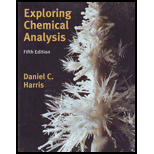
(a)
Interpretation:
Expression for ion selective electrode for
Concept Introduction:
Liquid- ion-selective electrode is composed of the hydrophobic ion-selective membrane that is essentially an organic
Potential difference for ion selective electrode is evaluated by expression as follows:
Here,
(a)
Explanation of Solution
Expression to compute potential of ion selective electrode is given as follows:
Substitute
(b)
Interpretation:
Change in voltage in millivolts when electrode is transferred from
Concept Introduction:
Refer to part (a).
(b)
Explanation of Solution
Expression to compute potential difference for ion selective electrode is evaluated by expression as follows:
Substitute 3 for
Conversion factor to convert
Hence potential of
Hence voltage change is
(c)
Interpretation:
Change in voltage in millivolts when electrode is transferred from
Concept Introduction:
Refer to part (a).
(c)
Explanation of Solution
Expression to compute potential difference for ion selective electrode is evaluated by expression as follows:
Substitute 3 for
Conversion factor to convert
Hence potential of
Hence voltage when
(d)
Interpretation:
Voltage when
Concept Introduction:
Refer to part (a).
(d)
Explanation of Solution
Substitute
Expression to compute response of ion selective electrode due to
Substitute0.17888 for constant,
Hence potential of
Hence voltage when
Want to see more full solutions like this?
Chapter 15 Solutions
Exploring Chemical Analysis
- Draw the Zaitsev product of the dehydration of this alcohol. + I X 5 OH ざ~ TSOH Click and drag to start drawing a structure.arrow_forwardPlease help with identifying these.arrow_forwardFor the reaction: CO2(g) + H2(g) --> CO (g) + H2O (g) Kc= 0.64 at 900 degrees celcius. if initially you start with 1.00 atmoshpere of carbon dioxide and 1 atmoshpere of hydrogen gas, what are the equilibrium partial pressuses of all species.arrow_forward
- Can I please get this answered? With the correct number of significant digits.arrow_forwardDraw the Hofmann product of the dehydroiodination of this alkyl iodide. ☐ : + Explanation Check esc F1 2 3 I 88 % 5 F5 I. X © tBuOK Click and drag to sta drawing a structure. © 2025 McGraw Hill LLC. All Rights Reserved. Te BI BB F6 W E R Y S H Karrow_forwardCan I please get help with this graph, if you could show exactly where it needs to pass through please.arrow_forward
 ChemistryChemistryISBN:9781305957404Author:Steven S. Zumdahl, Susan A. Zumdahl, Donald J. DeCostePublisher:Cengage Learning
ChemistryChemistryISBN:9781305957404Author:Steven S. Zumdahl, Susan A. Zumdahl, Donald J. DeCostePublisher:Cengage Learning ChemistryChemistryISBN:9781259911156Author:Raymond Chang Dr., Jason Overby ProfessorPublisher:McGraw-Hill Education
ChemistryChemistryISBN:9781259911156Author:Raymond Chang Dr., Jason Overby ProfessorPublisher:McGraw-Hill Education Principles of Instrumental AnalysisChemistryISBN:9781305577213Author:Douglas A. Skoog, F. James Holler, Stanley R. CrouchPublisher:Cengage Learning
Principles of Instrumental AnalysisChemistryISBN:9781305577213Author:Douglas A. Skoog, F. James Holler, Stanley R. CrouchPublisher:Cengage Learning Organic ChemistryChemistryISBN:9780078021558Author:Janice Gorzynski Smith Dr.Publisher:McGraw-Hill Education
Organic ChemistryChemistryISBN:9780078021558Author:Janice Gorzynski Smith Dr.Publisher:McGraw-Hill Education Chemistry: Principles and ReactionsChemistryISBN:9781305079373Author:William L. Masterton, Cecile N. HurleyPublisher:Cengage Learning
Chemistry: Principles and ReactionsChemistryISBN:9781305079373Author:William L. Masterton, Cecile N. HurleyPublisher:Cengage Learning Elementary Principles of Chemical Processes, Bind...ChemistryISBN:9781118431221Author:Richard M. Felder, Ronald W. Rousseau, Lisa G. BullardPublisher:WILEY
Elementary Principles of Chemical Processes, Bind...ChemistryISBN:9781118431221Author:Richard M. Felder, Ronald W. Rousseau, Lisa G. BullardPublisher:WILEY





